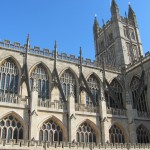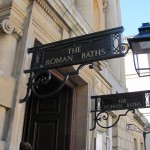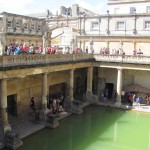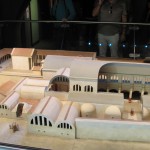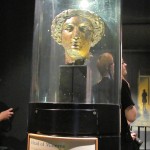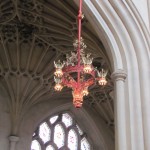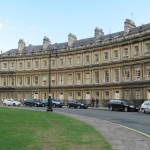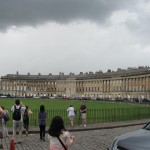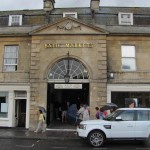To Bath and Beyond
Yesterday, most of the summer school students were given the day off to explore and study. I had most of the day free, except for a meeting to discuss the topic of my group presentation which will be part of the assessment for the summer school coursework. After reviewing our topic with Prof Craig Williams with my presentation partner Cindy from Shanghai, I met up with Cayla and Veronica to go into town. We started our day by finally finishing going through the exhibits at the Royal Albert Memorial Museum. (When we had visited before, we started at the top and never made it back down to the first floor!) Cayla had actually not seen any of the museum, so she enjoyed it in its entirety. I stayed on the ground level which housed an exhibition of historical and contemporary local art. It was fascinating to see the sketches of the City of Exeter as it looked over 100 years ago. Of course, the Cathedral was a prominent central feature to much of the artwork of the city from those times. One interesting painting, and quite a large one, depicted soldiers leaving for WWII. The images of the soldiers in uniform alongside the departing trains and their families was quite moving.
The ground floor of the museum also includes a historical record of Exeter from ancient times through the present. The fossils found in this area of England are astounding! It is hard to fathom the moors of Exeter as an ocean floor, or later, as the stomping grounds of woolly mammoths, but the fossil record is hard to argue with. Many artifacts from the period of Roman occupation in Britain were also on display. I really enjoy looking at the coins used during those times as well as the artisan artifacts of jewelry and metal-working. The craftsmanship of those ancient Romans rivals some of the best of today, and they truly did everything by hand! Later on in the museum, there are Victorian era displays of fashion and innovation– I for one am glad those dresses are no longer in style, too much fabric! The WWII era exhibit featured a reconstructed bomb shelter and video testimonies of the memories of people growing up here during the war and The Blitz. Exeter was bombed at several different locations, and it is hard to imagine what living in that type of fear would be like. One of the most interesting artifacts was a German Luftwaffe map of Exeter with places marked by Nazis for bombing. It is said that Hitler began targeting culturally and historically valuable sites in England as a retaliation of their bombing of a historic German church. Indeed, a bomb did hit near the southern end of the Cathedral and caused some damage, but nothing that was beyond repair.
After leaving the museum, we joined some other students for lunch at a local vegetarian restaurant, Herbies. Herbies has a completely vegetarian menu with lots of vegan and wheat free options as well. We all had a difficult time choosing just one thing off the menu, and I was very impressed with the variety of tasty options.
We spent the rest of the afternoon before dinner shopping around town. We also decided to stop at the local Bubble Tea shop. Their bubble teas were much different than the ones I was used to at home, but they were still good. I don’t think we succeeded in convincing Veronica that bubbles teas are the way to go though. They can take some getting used to.
After heading back to campus, we got ready for the day trip to Bath and began planning exactly how we could fit everything into a one day time limit…some strategic mapping was in order!
Today, we boarded coaches once again and traveled to the famous and ancient city of Bath. Our day in Bath began with the city’s namesake, the Roman Baths. The group I was in decided to tour the baths first before there were long lines. After getting into the complex, I was surprised at the sheer size of it. Roman baths were more than simple swimming pools, they included recreational areas, courtyards, and temples. This bath uses water heated from one of Britain’s only natural hot springs and a sophisticated Roman plumbing system to disburse it throughout the different pools in the complex. The large central pool is quite stunning: bright green water surrounded by pillars and statues of famous Romans rulers and conquerors. Some of these were British additions after the baths were rediscovered. The original construction would have enclosed the baths with a large domed roof, but they have long since been open-air.
The provided audio tour guides gave interesting facts about the various pools and chambers of the Roman Bath. Many artifacts and ruins from the other buildings, temples, and altars on site have been preserved for viewing and models are on display showing what the entire area would have looked like in its day. Some of the interesting remains include the full skeleton of a Syrian man buried on the premise in Roman times, lead fragments with requests to the gods written on them that were left in temple areas, and pediment fragments from the temple facade featuring an enormous Gorgon medallion. The temple on site is believed to have been devoted to the god Minerva. Before leaving the baths, we tasted the spring water for ourselves at the “guest” fountain. It was a little iron-y, but overall palatable.
After the temple, we escaped getting bathed in the rain by touring the next door cathedral, Bath Abbey. It was built in much the same Gothic style as the Salisbury Cathedral and had beautifully ornate red chandeliers.
Once we left the temple, we walked down Gay Street to the Jane Austen Center. Two of Austen’s novels were set in Bath, Northanger Abbey and Persuasion, and she herself lived in Bath for five years. Those were five tumultuous years, as her, her sister, and their mother went from middle-class gentry to poverty following the death of Rev. Austen. Their struggle ended when a brother allowed them to live on one of his properties, much like her own characters in Sense and Sensibility. The Jane Austen Center provided a in-depth history of the life of Jane Austen and the development of her writing. Although much of her personal life remains unknown, her stories have impacted literature and film for decades. The Center itself is housed in a building much like one farther down the street that Austen lived in for several months following her father’s death. Besides the exhibit, it contains a Regency Tea Room and costumes from contemporary Austen-inspired films.
After leaving our Austen fan-fare behind, we walked toward The Circus (and past Austen’s actual house). The Circus is a roundabout surrounding by identical arching buildings. From The Circus, you can exit the roundabout onto Royal Crescent which is a street where many famous British figures have lived over the years. We then walked towards the famous Pulteney Bridge which is one of only two shopping bridges in Europe and also the site for the famous “jumping” scene from the recent Les Miserables movie. Before reaching the bridge, we stopped for lunch at the Pig and Fiddle Pub (mainly to escape the rain, but also because of the name). The Pig and Fiddle did not disappoint, though, and I really enjoyed the pumpkin and goat cheese quiche special. Pulteney Bridge was a really beautiful area with terraced waterfalls in the river below and wooded parks along the banks. The Bath Market on the bridge was a cute indoor stall market with local vendors for food, jewelry, tea, and bath products. Before headed back to the coaches, we stopped to admire the Abbey Gardens alongside the river. After taking our pictures, the rain drove us quickly, albeit intermittently since we stopped to take refuge under overhangs, back to the coaches to head back to Exeter. Although quite wet, we were satisfied by our accomplishment of seeing every site on our list…good job team!
- Bath Abbey
- Roman Bath Entrance
- Main Bath
- Bath Terrace
- Model of the Bath in Roman Times
- Minerva’s Head, from the temple
- Cathedral Chandeliers
- The Circus
- Royal Crescent
- Bath Markets on the Bridge
- Abbey Gardens
- Riverside
